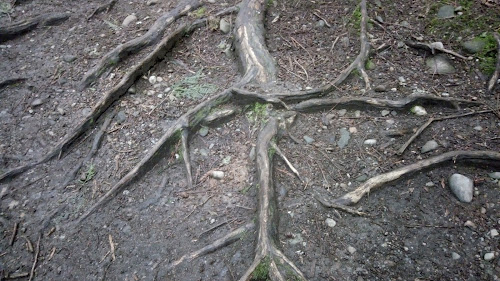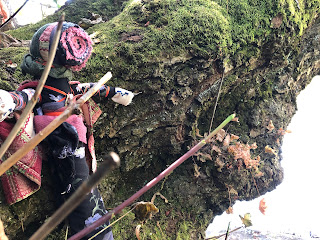Ceremonies of Reparation: Ceremony #8
Ceremonies of Reparation
For those interested in the
background of these ceremonies, please refer to the September 8, 2021 blog
entry.
Ceremony #8, Mar. 31, 2022
I stand on a roadside in Westholme
holding a motanka and two pysanky in my hands.
Looking out over the little valley where my husband’s field had been
brings a flood of memories. It feels
strange that a location we had lived at for such a brief time (4 months) would
carry such strong body memories. The
field remained active for the entirety of the growing season, so while we had
moved to another location mid-year, we still returned every other day to tend
to plants – extending our connection to the land much longer. Maybe it was this extension that made the time
more visceral, or perhaps it was simply the intensity of multiple moves in a
short time that heightened the full experience…
We initially walked the
property during winter to see if it would meet our needs. There was no snow on the ground as yet, and
we were preparing to leave the property in Maple Bay (see Ceremony #6). We drove down the long hillside laneway. At the bottom of the hill, the lane leveled
out before turning a corner and rising partway up another hill toward the
property structures. As we approached
the leveled area, the laneway was covered in over 6 inches of water. We slowly rolled through. The trees, rocks, and marshy areas were quite
beautiful. Turning the corner, however,
we were greeted with a shocking site.
The structures – barn, cabins, carport, and main house were dilapidated,
and garbage strew the ground in many places.
We parked near the top, just
in front of the carport, through which one had to walk in order to reach the
main house. There was little room to manoeuvre,
with piles of garbage, recycling and boxes filled with random items filling the
space top to bottom. A pile of plastic
bags filled with rotting meat lay to one side, the smell beginning to turn my
stomach.
We knocked on the front
door. No answer. We knocked again, waiting… Still no answer. I tried calling the number the landowner had
given us. Finally, the landowner
responded, and when she appeared at the front door, we could see that inside was
not much different than outside. She
invited us to see the house. We politely
declined, stating that we had other appointments and would prefer to walk the
land. I could not imagine how many years
of living without cleaning could lead to that level of grime.
The landowner explained she
was looking for helpers on the land, in the gardens and with the animals. Her health plus her time working were interfering
with her ability to attend to the farm. As
we walked together looking in and through structures as well as surveying the current
gardens and potential back-field growing opportunity, we continued to observe
unfinished projects, garbage clogging the ground and spaces, festering smells,
and unkempt animals.
As we left, I was highly aware
of my body. My heart was in grief – such
a beautiful piece of land, overlain by such neglect. My stomach and gut area felt like they had
been stabbed and torn. It was such a
strong reaction that I said to my husband that I could not – would not –
consider living there.
Two months later, with no
other prospects for land access to live and farm on, snow having arrived, and a
dispute over our yurt leaving us without a home, we returned to considering
this location. In the end, my husband
and I agreed that our time there would be spent cleaning and serving the land. We wrote a proposal with suggestions for cleaning
and increased hygiene – and that these would form part of our rent. The landowner agreed, though said that because
of winter conditions on the laneway, we would have to wait until the snows have
melted and waters receded.
When we finally had access to
the property, we set up a humble living space in a small 10x10 shack near the
established gardens and got to work. It became
interesting to see that even as garbage was cleared, more would appear. It took us some time to realize this wasn’t
just a case of neglect – it was preference, and not a preference we easily
understood.
When we finally came to a
conclusion about reclaiming out yurt, belongings, and beloved animals, we had 1.5
days to complete the entire move. I had put
out a call for help and a host of people – some I knew and some I did not know –
came out to help. It was extremely heart
warming and we actually managed to complete the task in the allotted time. However, it also meant that I was at the
previous homestead helping with packing and shipping things out while my
husband was at the new homestead receiving and unpacking trucks, vans, cars –
whatever anyone could offer in terms of transport. Two friends had managed to round up the Muscovy
ducks, as well as the mamma goat and her baby goat (whom she had given birth
to during the months we were estranged from her).
At the receiving end, my
husband was busy managing several loads of things when the friends arrived with
the ducks and goats. Unfortunately, not
knowing how intelligent and also frightened the goats were, they opened the
doors thinking they would be able to handle the goats and coral them into their
new pen. However, as soon as the latch
to the carrier opened, mamma goat bolted with baby goat beside her. The friends attempted to chase the goats,
only to have the animals even more spooked.
They took off up the laneway and out of sight!
The next day we made posters, which
we tacked up through the neighbourhood.
After a month, one neighbour called to say he had found the goats. They had managed to live in the hills not far
from where we were staying, but mamma goat (who was still nursing her babe) was
now extremely emaciated and had started coming down out of the hills to feed on
the food the neighbour left out for deer.
So, as soon as I could, I went
to the neighbouring property and enticed mamma and babe into the truck with
feed. Mamma was stressed but also relieved
to be with her people. Babe had never
been handled and took some coaxing to get into the truck. The short 5-minute drive back to the new location
was such a joy for me. I had been so
worried about these two beauties that I could feel the layers of stress begin
to slough off.
Over the few months we resided at this piece of land, I could not find Ma Honeysuckle anywhere there. And so, I began to befriend trees. The first tree who spoke to me said that this place would only be temporary and reiterated that our efforts are to serve the land in this location. I found a tuck-away spot in the back forest – private and quiet – for sitting with students and having ceremony. Slowly, bit by bit, the land began to breathe more freely as the landowner kept her collection habits closer to her home and allowed other parts of the property to shift. The land felt more vibrant and alive, the trees spoke freely, and we began to feel attuned to this little valley bowl near Solly’s Lake.
The trees and spirits of this place were helpers and teachers, and encouraged me to work with them daily. Each night I walked to the bowl, which opened to a stunning view of the night sky. Here I prayed and made offerings to the land and ancestors, and found solace. However hard I tried, however, I could not feel roots in this place. I knew in my heart that the whispers of that first tree were true.
We created a nursery filled with seedlings and plants, offering them for sale at local stores and through the local online platforms. When June arrived, someone who had purchased some of the plants in previous years approached us – would we consider moving (again) to their property to farm there? We decided to remain open and curious and view this potential new location. Given that we were already well into the growing season, we had to decide quickly. The decision was easy -- we moved yet again. (See Ceremony #2)
CEREMONY: March 31st,
2022
And so, as I stand on the
roadside, looking into the valley bowl, I want to leave the motanka and pysanka
to overlook the fields, marsh, lake, and trees.
As I have two pysanky, I decide to roll one down the little hillside to
rest in the thicket of blackberry vines overlooking this end of the bowl. It disappears from view.
This particular pysanka was designed with 4 panels -- one for the animals, one for the crops, one for Mati Zemlya (Great Mother Earth), and one for the trees who befriended me. The bands depict the waters that surround the land, and mountains, valleys and fertile fields.
Walking further down the road,
I enter a forest I have never walked. It
is not part of the “property” we lived on, but it is part of the
land. The forest sits next to Solly’s
Lake, opposite to where the growing-field had been and again feels like an
appropriate place for the remaining pysanka and motanka to overlook the whole
of the bowl.
Entering the forest, I ask that a tree offer itself as keeper of the sacred items. Within a short time, a beautiful tall maple calls out to me. Approaching the tree, I bury the pysanka at the base on one side, and the motanka on the other.
The second pysanka was originally going to depict symbols of protection in an orderly and neat fashion. However, as the spirits would have it, the wax began to drip and flow in unpredictable (messy) ways, so I decided not to fight the wax, but rather listen to it. What emerged were symbols of protection for land and animals, and a form of the Mother Mokosh I often work with.
The motanka is made with earthen and water colours. The pattern of her underskirt is similar to that which depicts fertile fields on the pysanky. She holds a satchel in each hand -- filled with chard seed and herbs used traditionally in Ukraine for offering smoke clearing and blessings.
I pause to offer prayers and gratitude, apologies for transgressions during my time there, and to request that the medicine of my ancestors serve to protect and help the land, spirits and ancestors, and peoples of the land. As I walk back out of the forest, I stand one more time where the first pysanka had been rolled down the hillside and repeat these prayers.
The day feels serene. The ceremony feels complete.






















Comments
Post a Comment